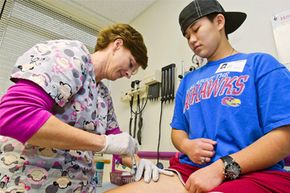The idea of getting stuck in the wrong body sounds like the premise for a movie in "Freaky Friday," a mother and a daughter swap bodies, and in "Big" and "13 Going on 30," teenagers experience life in an adult's body. These movies derive their humor from the ways in which the person's attitude and thoughts don't match their appearance. A teenager trapped in her mother's body, for example, revels in breaking curfew and playing air guitar, while a teenager trapped in an adult's body is astounded by the trappings of wealth that come with a full-time job. We laugh because the dialogue and actions are so contrary to what we'd expect from someone who is a mother, or from someone who is an employed adult.
But for some people, living as an incongruous gender is anything but a joke. A transgender person is someone who has a different gender identity than their birth sex would indicate. We interchange the words sex, sexuality and gender all the time, but they don't actually refer to the same thing. Sex refers to the parts we were born with; boys, we assume, have a penis, while girls come equipped with a vagina. Sexuality generally refers to sexual orientation, or who we're attracted to in a sexual and/or romantic sense. Gender expression refers to the behavior used to communicate gender in a given culture. Little girls in the U.S., for example, would be expected express their feminine gender by playing with dolls and wearing dresses, and little boys would be assumed to express their masculinity with penchants for roughhousing and monster trucks. Another term is gender identity, the private sense or feeling of being either a man or woman, some combination of both or neither [source: American Psychological Association].
Advertisement
Sometimes, a young boy may want to wear dresses and have tea parties, yet it's nothing more than a phase that eventually subsides. Other times, however, there is a longing to identify with another gender or no gender at all that becomes so intense that the person experiencing it can't function anymore. Transgender is an umbrella term for people who identify outside of the gender they were assigned at birth and for some gender reassignment surgeries are crucial to leading a healthy, happy life.









